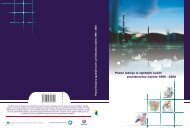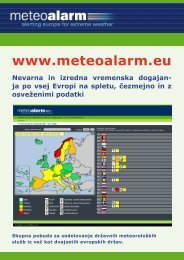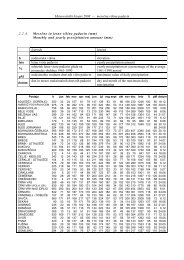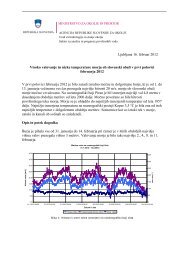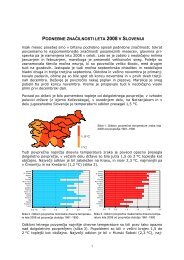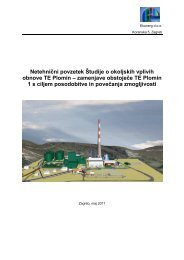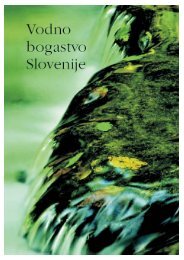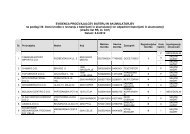Water Quality in Slovenia - Agencija RS za okolje
Water Quality in Slovenia - Agencija RS za okolje
Water Quality in Slovenia - Agencija RS za okolje
Create successful ePaper yourself
Turn your PDF publications into a flip-book with our unique Google optimized e-Paper software.
26<br />
2.2<br />
W A T E R Q U A L I T Y I N S L O V E N I A<br />
In 2006, the quantitative sampl<strong>in</strong>g of benthic <strong>in</strong>vertebrates and phytobenthos, carried out by<br />
sampl<strong>in</strong>g multimicrohabitat types <strong>in</strong> selected water bodies, was carried out <strong>in</strong> <strong>Slovenia</strong> for the first<br />
time. The samples were laboratory proceeded (sub-sample sort<strong>in</strong>g and determ<strong>in</strong>ation to required<br />
level) us<strong>in</strong>g new national methodology (18, 19, 20). They were evaluated accord<strong>in</strong>g to the expert<br />
groundwork for the assessment of the organic pollution of rivers by us<strong>in</strong>g an adapted saprobic <strong>in</strong>dex<br />
based on of benthic <strong>in</strong>vertebrates and phytobenthos (21, 22). Only 22 selected rivers were analysed.<br />
Sampl<strong>in</strong>g and further laboratory proceed<strong>in</strong>gs of 37 monitor<strong>in</strong>g sites showed that, accord<strong>in</strong>g to<br />
quality assessment based on phytobenthos, 43% of monitor<strong>in</strong>g sites had a high status, 32% a good<br />
status, 22% a moderate status and 3% had a poor quality status. The results of benthic <strong>in</strong>vertebrates<br />
sampl<strong>in</strong>g and analysis, however, showed that 57% of monitor<strong>in</strong>g sites had a high status, 27% a<br />
good status, 11% a moderate status, 3% a poor status and 3% had a bad quality status. It should be<br />
emphasized that this assessment has been made based on only two biological quality elements, for<br />
only one pressure (organic pollution) and at selected monitor<strong>in</strong>g sites.<br />
In the follow<strong>in</strong>g years, a classification of the ecological status will be presented, represent<strong>in</strong>g the<br />
measurement of the alteration of the ecosystem’s structure and function<strong>in</strong>g from the natural state,<br />
i.e. the state where there are no, or only very m<strong>in</strong>or human impact. The assessment of the ecological<br />
status is based on biological quality elements (phytoplankton, phytobenthos and macrophytes, fish<br />
and benthic <strong>in</strong>vertebrates) and on hydromorphological, chemical and physico-chemical elements<br />
support<strong>in</strong>g the biological elements. The assessment system will enable a dist<strong>in</strong>ction between five<br />
classes of ecological status: “high”, “good”, “moderate”, “poor” and “bad”. S<strong>in</strong>ce the start<strong>in</strong>g po<strong>in</strong>ts or<br />
reference conditions of water bodies are different, a type-specific approach will be used whereby<br />
the waters are classified <strong>in</strong>to types accord<strong>in</strong>g to their natural characteristics and then reference<br />
conditions are def<strong>in</strong>ed for each type (27, 28, 29, 30). The evaluation of the ecological status of rivers<br />
<strong>in</strong> <strong>Slovenia</strong> will be possible only when assessment methods for all biological quality elements and<br />
different pressures are prepared.<br />
<strong>Quality</strong> of Lakes<br />
With <strong>Slovenia</strong>’s association with the European Union, the <strong>Water</strong> Framework Directive (1) has become<br />
the b<strong>in</strong>d<strong>in</strong>g and key document <strong>in</strong> the field of water management and has also <strong>in</strong>fluenced changes<br />
<strong>in</strong> the monitor<strong>in</strong>g of lake quality. The period from 2003 to 2006 was actually a transitional period for<br />
the implementation of the <strong>Water</strong> Framework Directive, which has brought important changes <strong>in</strong> lake<br />
sampl<strong>in</strong>g and, most of all, a new, <strong>in</strong>tegrated approach for the assessment of ecological status, which<br />
could not be used <strong>in</strong> that period due to the assessment methods still <strong>in</strong> the course of preparation.<br />
Until 2002, national monitor<strong>in</strong>g of lake quality was carried out only on Lake Bled, Lake Boh<strong>in</strong>j and<br />
Cerknica Lake. S<strong>in</strong>ce 2003, due to the requirements of the <strong>Water</strong> Framework Directive, the monitor<strong>in</strong>g<br />
has also <strong>in</strong>cluded artificial lake, reservoirs and river accumulations of an area larger than 0.5 km2 (31,<br />
32), which are accord<strong>in</strong>g to the Rules of identification and classification of surface water bodies (15)<br />
def<strong>in</strong>ed as water bodies (Map 3, Table 5). These are the follow<strong>in</strong>g: Lake Bled, Lake Boh<strong>in</strong>j, Velenje Lake,<br />
Šmart<strong>in</strong>sko Lake, Slivniško Lake, Perniško Lake, Gajševsko Lake and Ledavsko Lake, the reservoirs<br />
of Klivnik, Molja and Vogršček, as well as the river accumulations of Moste, Mavčiče, Vrhovo and<br />
Ptuj Lake. Monitor<strong>in</strong>g was due to a high rate of flow not carried out only <strong>in</strong> Ormož Lake, but it was<br />
nevertheless performed as part of the monitor<strong>in</strong>g programme of rivers. In the river accumulations<br />
of Mavčiče, Vrhovo and Ptuj Lake, monitor<strong>in</strong>g was carried out only <strong>in</strong> the event of the ‘bloom<strong>in</strong>g’ of<br />
phytoplankton, which is characteristic of the dry season when the rate of flow <strong>in</strong> river accumulation<br />
is at its lowest and the accumulations are given the status of stand<strong>in</strong>g water bodies.<br />
The <strong>in</strong>termittent Cerknica Lake, which does not have any common characteristics with permanent<br />
lakes, was <strong>in</strong>cluded <strong>in</strong> monitor<strong>in</strong>g of lakes <strong>in</strong> the years 1993 to 2005. S<strong>in</strong>ce there are Karst Rivers,<br />
which dur<strong>in</strong>g high waters tend to flood the Cerknica field, the sampl<strong>in</strong>g and assess<strong>in</strong>g the lake were<br />
carried out <strong>in</strong> accordance with the criteria for rivers, and the status of Cerknica Lake is also presented<br />
<strong>in</strong> the data for rivers.




